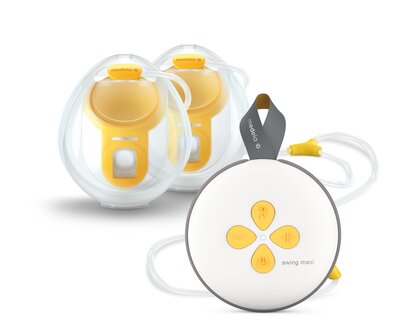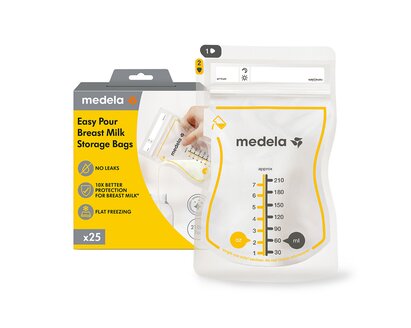It’s normal to be worried about all the changes and even more normal to be concerned about what your body will look like after pregnancy and breastfeeding. Our modern culture is obsessed with seeing women “bounce back” to their pre-pregnant selves but is this a reality?
Body and breast changes are a normal part of pregnancy and breastfeeding… and our bodies take time to recover. A common fear that pregnant women have is that if they do breastfeed, they will be left with unwanted, unwelcomed and permanent breast changes.
If you're concerned that breastfeeding is the culprit for causing saggy boobs, you can take a breath out because research shows that breastfeeding does not cause your breasts to sag (happy dance!) A group of plastic surgeons that perform breast lifts and breast augmentations studied the connection between sagginess and breastfeeding and they found no correlation.
So, What Does Cause Breasts to Sag?
Research shows that is more likely to be your pregnancy, rather than breastfeeding that causes your breasts to sag and there is a connection between the number of times a woman has been pregnant and how saggy her breasts were.
They also found that a history of smoking contributed to sagginess, which they attributed to the negative effect that smoking has on elastin, a protein in skin, which keeps it looking youthful and helps support the breast.
What Other Factors Cause Breasts to Sag?
There are also other contributing reasons that a woman may experience sagging breasts:
- Your genetics - skin elasticity and stretch marks are normally a matter of genetics and skin type; if you’re predisposed to stretch marks, there’s not much you can do to prevent them – but the good news is they will fade and become much less noticeable over time
- Aging -the loss of skin elasticity due to aging is the most common cause of saggy breasts
- Gravity - gravitational pull takes its toll, especially on women with larger breasts. You may find it helpful to wear a comfortable and well-fitted bra during pregnancy to support your breasts as they grow. For more information about when to get a maternity bra, read here.
- High body mass index - fluctuations in weight can cause unnecessary stretching of the breasts. Maintaining a healthy weight will help women avoid the progression of unnecessary stretching
- Menopause -a drop in the hormone estrogen, which occurs normally during menopause, may be associated with a decrease in tissue collagen.
- Smoking -carcinogens in cigarette smoke cause elastin to break down in the body. Elastin fibres are responsible for skin elasticity throughout the body.
Breast Changes During Pregnancy
During pregnancy, your breasts undergo a multitude if changes. “Breast growth in pregnancy may be rapid during the early weeks, or the size may increase gradually,” explains Dr Jacqueline Kent, a leading lactation researcher at the University of Western Australia.
“Every woman is different. Your breasts might not grow much until shortly before – or even after – the birth. But if you’re wondering how much breasts grow during pregnancy in total, by the time your milk comes in they’re likely to be almost one-and-half times bigger than before you became pregnant!”
Breast size is determined by how much fatty tissue there is. Making milk creates denser tissue in your breasts
Breastfeeding research associate at Medela, Dr Danielle Prime, says, “From around your 15th week of pregnancy the new milk-producing cells in your breasts become active, and by around week 22 they start making milk.
During the second trimester, you may notice your nipples and areolae (the circles of skin surrounding them) becoming larger and darker.” Another way the areola changes is that the little bumps or pimples on it become more noticeable. These wonderfully named “Montgomery’s tubercles” produce a moisturising oil that helps protect against soreness and infection once you start breastfeeding.
In fact, scientists believe the smell of this oil is similar to amniotic fluid and may help guide your newborn to your nipples after she’s born.” Your breasts may start to feel heavy or sore again during the last trimester. Every woman is different, but your breasts are likely to be around one to two bra cup sizes bigger than before pregnancy.
Check out this Medela article to learn more about breast changes before and after birth.
What Can I Do to Help Prevent My Breasts from Sagging?
So, is there anything that you can do to prevent your breasts from sagging during the pregnancy and breastfeeding periods? Actually, maybe!
- Wean gradually – when you are ready to plan to wean, leave time to do it gradually. The more gradually you wean, the more you will help the fat tissue to redeposit inside breasts. That will help them regain their pre-pregnancy appearance more quickly.
- Avoid Rapid Weight loss – Breastfeeding can help women lose their pregnancy weight but be careful to do it slowly. If you find that the kilograms are just falling off, your skin won't be able to keep up. Try to lose weight gradually so that your skin has time to change too.
- Practice good posture – You can strengthen the muscles that hold the breasts up and work on your posture. Have you noticed that while you are breastfeeding, you tend to slouch? When we hold ourselves up with good back posture, our breasts follow along and don't sag as much.
- Maintain a healthy weight – Eat a well-balanced diet, get a little exercise and try not to gain or lose weight too quickly.
- Drink plenty of water – keep your skin healthy and hydrated to try to preserve its elasticity.
- Don't smoke – try to quit smoking. The health benefits of quitting smoking are endless. Smoking is not healthy for you, your baby or your breasts.
- Exercise – by exercising your pectoral and back muscles, you will build the strength required to hold your breasts up, making them appear more toned
There is Hope!
“After six months of breastfeeding, expect your breasts to start becoming smaller,” explains Dr Kent. “This is not an indication that you’re producing less milk, but it may be that you’re losing some of the fatty tissue in the breast.
By the time your baby is 15 months old, you can expect your breasts to be the same volume they were before conception, but not smaller. This is true whether you’re still breastfeeding or not.” This seems to be because your breasts work more efficiently after six months, which Dr Kent’s study found may be due to a redistribution of breast tissue.
When you eventually stop breastfeeding your baby – whether that’s after three weeks, three months or three years – breast changes due to lactation will reverse. “When you wean completely you can expect your breasts to return to similar to preconception size over the next three months if they haven’t already,” explains Dr Kent.
But if you get pregnant again, the whole process will begin anew. Since breastfeeding slowly works off the fat that gives breasts their size, women who breastfeed for several years may find that their breasts feel deflated. With time, the fat will be redeposited and their breasts will return to their pre-pregnancy size.
One team of researchers found that women perceived their breasts as being smaller than they had been before getting pregnant, despite being their original size.
Did you have any concerns about how breastfeeding might cause your breasts to sag a little? What advice would you give to other mums who may have similar concerns? Let’s have a chat here or on the Medela Australia Facebook page!






















































